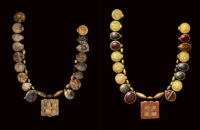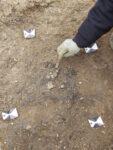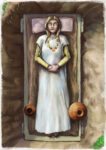 A 7th century burial discovered in the Northamptonshire village of Harpole contains a gold and gemstone necklace that is the richest ever discovered from the period.
A 7th century burial discovered in the Northamptonshire village of Harpole contains a gold and gemstone necklace that is the richest ever discovered from the period.
Museum of London Archaeology (MOLA) archaeologists were engaged to excavate a site before construction of a housing development. It didn’t seem at first glance like the site would have a great deal of archaeological material to offer. There was no necropolis known in the area, no church. The only archaeological find of any significance ever made in Harpole was a Roman mosaic from a villa found in the mid-19th century in another part of town, and that was removed a hundred years ago.
 Then, on the last day of the eight-week excavation, lead archaeologist Levente Bence Balázs was sorting through what he thought was a garbage pit when he came across some teeth. Then he saw the glitter of gold from what proved to be the rectangular garnet-inlaid central pendant of an ornate gold necklace. In total there were 30 pendants and beads on this one necklace. They were made of gold, garnets, colored glass, other semi-precious stones and Roman gold coins repurposed as pendants.
Then, on the last day of the eight-week excavation, lead archaeologist Levente Bence Balázs was sorting through what he thought was a garbage pit when he came across some teeth. Then he saw the glitter of gold from what proved to be the rectangular garnet-inlaid central pendant of an ornate gold necklace. In total there were 30 pendants and beads on this one necklace. They were made of gold, garnets, colored glass, other semi-precious stones and Roman gold coins repurposed as pendants.
 The necklace turned out to be part of the bed burial of a high-status individual who had died between 630 and 670 A.D. The bones have long since disintegrated, but the necklace is evidence that the deceased was female, as is the bed burial itself, a funerary practice almost exclusively reserved for elite women in the Saxon period. She was not wearing the necklace when she was buried. It was placed next to her on the bed.
The necklace turned out to be part of the bed burial of a high-status individual who had died between 630 and 670 A.D. The bones have long since disintegrated, but the necklace is evidence that the deceased was female, as is the bed burial itself, a funerary practice almost exclusively reserved for elite women in the Saxon period. She was not wearing the necklace when she was buried. It was placed next to her on the bed.
 Two pots were buried on either side of her lower legs. They contain an organic residue, the first such pot with analyzable contents found. Another artifact was removed in a soil block for excavation in laboratory conditions, and an X-ray revealed it is a large, elaborately decorated silver cross mounted on wood placed face-down. The cross features never-before-seen depictions of oval human faces made of silver with blue glass eyes.
Two pots were buried on either side of her lower legs. They contain an organic residue, the first such pot with analyzable contents found. Another artifact was removed in a soil block for excavation in laboratory conditions, and an X-ray revealed it is a large, elaborately decorated silver cross mounted on wood placed face-down. The cross features never-before-seen depictions of oval human faces made of silver with blue glass eyes.
Few of these burial sites date back earlier than the 7th century AD, when burials of high-status men were more common, and as Christianity took root, later graves rarely featured valuable objects because being buried with ornate jewelry, such as the necklace, was frowned upon by the early Christian Church, said Lyn Blackmore, a senior finds specialist at MOLA.
“The Harpole Treasure, it’s not the richest (bed burial) in terms of the number of artifacts but it is the richest in terms of investment of wealth … and it has the highest amount of gold and religious symbolism,” she said at a news briefing. […]
Organic matter found in the grave is thought to contain fragments of feathers and textiles like leather, and further study should uncover the nature of the bed burial and whether it had a cover or canopy. The two pots were Frankish in style, Blackmore said, suggesting they came from what is now France or Belgium. The archaeologists hope molecular analysis will allow them to identify the residue in the pots; to date, their analysis has ruled out myrrh.
The woman buried in this exceptional grave was a leader in an early Christian community during the short transitional period between pagan burials with all their grave goods and the burials of established Christianity which explicitly eschewed grave goods. She was wealthy and powerful, likely born to a prominent family and held an important religious position like an abbess.